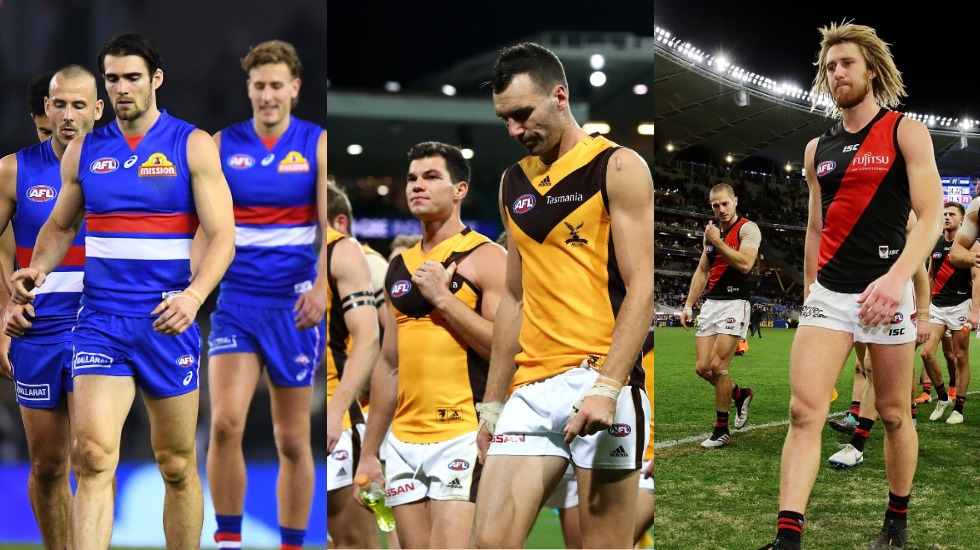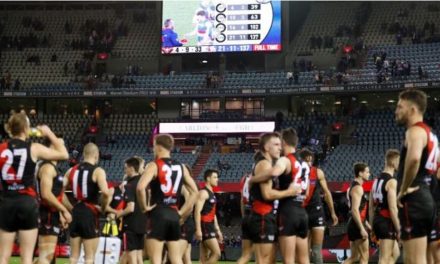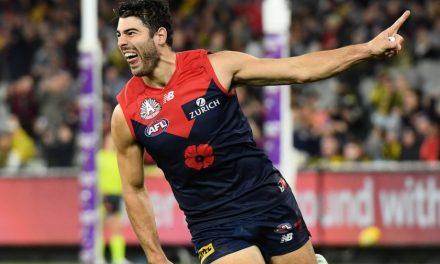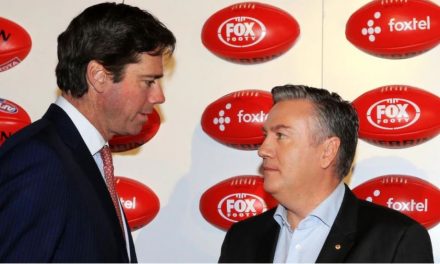The Western Bulldogs, Hawthorn and Essendon leave the ground after their Round 14 losses. It wasn’t always thus.
The AFL media can be a voracious beast at times, always searching relentlessly for the next great narrative to devour.
Sometimes there just aren’t that many stories around, particularly during the bye rounds, and that chase becomes even more difficult. It means some fairly long bows can be drawn. Like this supposed crisis or that.
And this week’s, along with the usual band of AFL coaches under pressure, appears to be the state of Victorian clubs, eight out of 10 of whom are currently consigned to the bottom half of the ladder, the top eight comprising six non-Victorian teams along with Geelong and Collingwood.
Monday’s “Herald-Sun” summed it up thus. “Makes for worrying viewing”. “It is a real concern”. “It amounts to one sick state of football”. I’d sum those sweeping generalisations up thus: No it doesn’t. No it isn’t. And no it doesn’t.
You don’t have to go beyond the top of the AFL ladder to find the sizeable flaws in this argument. On top sits Geelong, a game clear with a record of 11-2. Next is Collingwood, on 10-3, and a game clear of third spot.
And if ever you wanted evidence of the media’s tendency for goldfish memories, this is it. Just nine months ago, on preliminary final weekend, three of the four teams plying off for a grand final spot were Collingwood, Richmond and Melbourne, five Victorian clubs having reached the finals a couple of weeks previously.
West Coast’s premiership win made the Eagles only the second non-Victorian club to win a flag in the last dozen. Yep, Victorian teams have won 10 of 12 since 2007. If that’s sickness, lord knows what sort of domination a healthy diagnosis entails.
You’d think we might have learned. For it was early in 2007, when sides from other states had had the temerity to win three successive premierships, that the panic button was last pushed in Victoria.
The premise then was that 10 clubs in one state were fighting over too small a resource base and that well-heeled clubs from other states were becoming financial monoliths, that wealth reflected in better facilities and better quality coaching and development, the discrepancies growing by the year.
The angst reached such levels that there was much discussion about summits into the crisis in Victorian football and supposed dwindling interest in the AFL’s foundation state.
What happened next? Well, almost on cue, Geelong launched one of the greatest eras of sustained success the AFL era has seen, one landing three premierships in the space of five seasons.
Hawthorn under the coaching of Alastair Clarkson matured ahead of time, landing a surprise premiership in 2008, and keeping that run going long enough to win another hat-trick of them in 2013-15. Collingwood won its first premiership for 20 years and reached another grand final. And St Kilda and the Western Bulldogs were also consistent forces near the top of the ladder.
In the dozen completed seasons since 2007, there’s been on average five Victorian clubs in the top eight each year. There’s only been fewer than four once. And in a competition comprising 10 clubs from Victoria and eight from beyond isn’t that about the sort of balance it should be?
Those concerns about financial juggernauts like West Coast and Adelaide spending their way to premierships ahead of their poorer Victorian brethren have also effectively been snuffed out by the AFL’s introduction of a “soft” salary cap on football department spending in 2015, by which clubs pay a 100 per cent tax on any money over and above the limit set for football budgets.
So why are a number of Victorian clubs struggling at the moment? Simple. The greater ups and downs of an equalised competition.
It’s seeing fewer and shorter periods of dominance from any clubs, regardless of where they’re from. There’s more clubs now, less depth in senior playing lists, and more vulnerability to injuries.
That’s had a lot to do with Richmond’s issues so far in 2019. Melbourne, still overall a youngish and raw playing group, hasn’t coped well with injuries and a raft of surgeries to key players which ate into their pre-seasons.
Hawthorn, after fighting against the tide so long, is finally starting to feel the pinch of the system and the ageing process. Essendon, the Western Bulldogs and North Melbourne, meanwhile, are still just a little short on the quality needed to mix it with the top of the ladder and are prone to inconsistency.
But it’s not long ago those were the sorts of tales being told by some of the non-Victorian clubs. And some of those whose fortunes are now on the up are providing storylines even supporters of those struggling Victorian clubs can embrace.
Who’d deny Brisbane its successes this season after going without even a single finals appearance for 10 years?
The Lions under popular coach Chris Fagan have done it tough for long enough. The development of their younger brigade has been a study in the careful building of a playing list good enough to provide them with several more seasons yet of success.
They’re quick, skilful and great to watch. And there doesn’t appear to be much evidence of Victorian club supporters railing against their rise up the ladder like some evil would-be superpower.
And as much as anything, that’s because footy fans in the heartland are more indifferent than antagonistic towards the teams from other states. In fact, the bulk would probably much rather they have success than any local rival.
They also know that, given the equalisation measures of modern day football and the cyclical nature of teams’ fortunes, there’s a good enough chance it will be their team’s turn soon enough.
So spare us the “sky is falling Melbourne” tropes please, guys. They’re inaccurate for starters, and they’re a pretty shallow read on the state of play in the AFL competition, whether it’s one, two or half-a-dozen Victorian teams which end up playing in finals this season.
*This article first appeared at SPORTING NEWS.












Totally agree with the premise, Rohan, but there was small statistical error – that correctly stated would have given even more weight to your argument.
“For it was early in 2007, when sides from other states had had the temerity to win three successive premierships…”
Maybe what you meant to say was that interstate sides had contested the three previous grand finals. Because, interstate sides had won the previous 6 (Lions, Lions, Lions, Power, Sydney, Eagles).
In fact, between 1992 and 2006, interstate sides won 92, 94, 97, 98, 2001-06. So, 10 of 15 flags. For Victorian clubs that’s much more like a crisis. 33% success from 56% representation. And as you say, then the Vic clubs went berserk, winning 10 of the next 12.
It would clearly seem it’s the interstate clubs now facing a crisis, with just 17% win rate from 45% representation.
Neither periods of dominance is ideal – although personally I’m more concerned about the dominance of the Vic teams in the last 12 years, especially the last 6.
However, the distribution of flags should reflect the representation of Victorian and interstate teams.
And since the AFL began in 1991, Victoria clubs have won 16 flags, and interstate sides have won 12. For a 43% / 57% split…
That’s pretty damn close enough to the natural equilibrium to be happy!